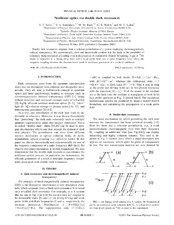| dc.creator | Yelin, S. F. | |
| dc.creator | Sautenkov, V. A. | |
| dc.creator | Kash, M. M. | |
| dc.creator | Welch, George R. | |
| dc.creator | Lukin, M. D. | |
| dc.date.accessioned | 2011-09-08T21:36:10Z | |
| dc.date.available | 2011-09-08T21:36:10Z | |
| dc.date.issued | 2003 | |
| dc.identifier.citation | S. F. Yelin, V. A. Sautenkov, M. M. Kash, George R. Welch and M. D. Lukin. Phys.Rev.A 68 063801 2003. "Copyright (2003) by the American Physical Society." | en |
| dc.identifier.uri | http://dx.doi.org/10.1103/PhysRevA.68.063801 | |
| dc.identifier.uri | https://hdl.handle.net/1969.1/126569 | |
| dc.description | Journals published by the American Physical Society can be found at http://publish.aps.org/ | en |
| dc.description.abstract | Double dark resonances originate from a coherent perturbation of a system displaying electromagnetically induced transparency. We experimentally show and theoretically confirm that this leads to the possibility of extremely sharp resonances prevailing even in the presence of considerable Doppler broadening. A gas of Rb-87 atoms is subjected to a strong drive laser and a weak probe laser and a radio frequency field, where the magnetic coupling between the Zeeman levels leads to nonlinear generation of a comb of sidebands. | en |
| dc.language.iso | en | |
| dc.publisher | American Physical Society | |
| dc.subject | ELECTROMAGNETICALLY INDUCED TRANSPARENCY | en |
| dc.subject | GROUP-VELOCITY | en |
| dc.subject | ATOMIC VAPOR | en |
| dc.subject | LIGHT | en |
| dc.subject | GENERATION | en |
| dc.subject | STORAGE | en |
| dc.subject | GAS | en |
| dc.subject | Optics | en |
| dc.subject | Physics | en |
| dc.title | Nonlinear optics via double dark resonances | en |
| dc.type | Article | en |
| local.department | Physics and Astronomy | en |


